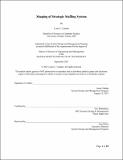Shaping of Strategic Staffing System
Author(s)
Catalan, Louis C.
DownloadThesis PDF (3.602Mb)
Advisor
Rebentisch, Eric
Terms of use
Metadata
Show full item recordAbstract
The workforce is the greatest asset of every business, and the success of an organization lies in its ability to bring and keep top talents within. This is because the workforce or the people execute plans, create and perform processes and strategies to deliver business results. For organizations to execute business strategies effectively, it needs the right quality and quantity of workers. It needs to have the right number of people with the right skills at the right time, location, and cost, and intertwining all these variables is not easy.
Workforce planning is an effective methodology in addressing talent management ambiguity. The traditional method of pen and paper or the widely used spreadsheets are some ways to perform workforce planning; however, the dynamic elements of Strategic Workforce Planning make these tools somewhat irrelevant. The fast-paced evolving technology and constantly changing market needs dynamically changes business priorities, requiring a more effective tool that continuously aligns people strategy to business strategy.
This research explores a Strategic Staffing System's functionalities that enable a business to meet the workforce demand. Several leading workforce management systems were studied. A key finding is that not a single technology addresses 100% of the stakeholder's functional requirements, but components from multiple systems did. The System Engineering’s Concept Selection Method was used to surface the best components and generate new concepts to meet users’ needs.
This study suggests that there is no ready-to-use system that fully caters to stakeholder’s needs. The components of a “world-class” Strategic Staffing system are available yet; it needs to be built as a single integrated system. Until the proposed concept is operationalized, businesses can buy what is currently offered in the market or redesign existing technologies that will address the greater need.
Date issued
2021-09Department
System Design and Management Program.Publisher
Massachusetts Institute of Technology